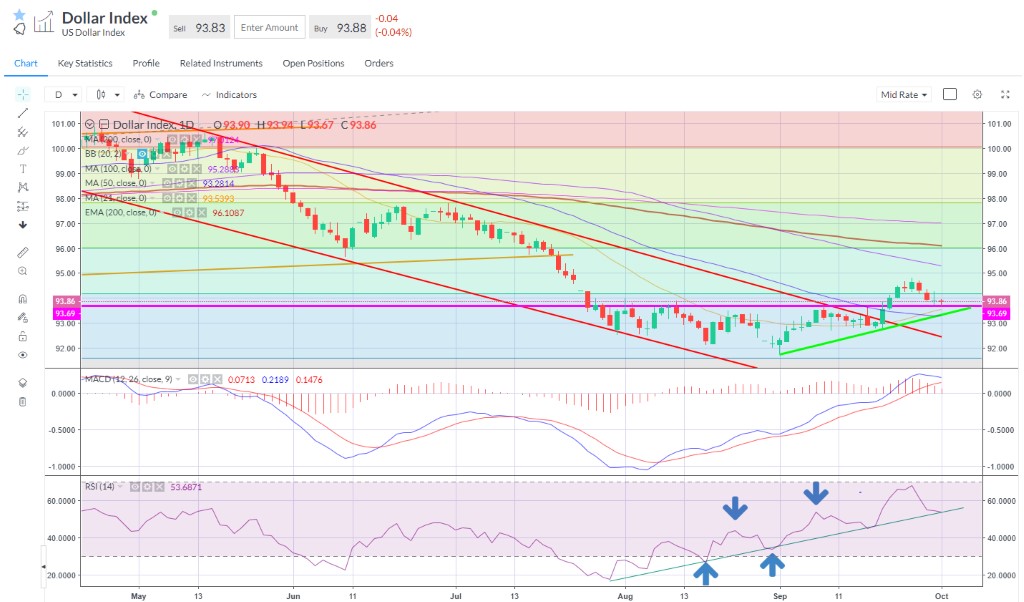
Thursday Oct 1 2020 08:34

5 min
Stock market bulls got the signal they needed from US Treasury secretary Steven Mnuchin, who said the White House was serious about doing a deal with House Democrats on a stimulus package. Nevertheless, no agreement was reached after talks between Mnuchin and Nancy Pelosi.
The Democrats pulled a vote on their $2.2tn package; the White House has come up with a $1.5tn counteroffer. Stimulus is coming, the question really is only when – a deal before the election still looks difficult. Meanwhile end of month and end of quarter flows likely had a positive impact after a soft September.
The S&P 500 rallied and closed above its 50-day moving average, perhaps offering bulls a signal of strength. The next major level is 3,400 and then the Sep 16th intra-day high at 3,428. The close at 3,363 left the broad market down 3.9% in September, its first down month since March. The Dow Jones fell 2.3% last month, while the Nasdaq was more than 5% weaker for September.
European markets did not fall as much, but they also didn’t rally as much in August. In fact, European equities have been stuck in a range for months now and are failing to really spark into life. Cyclically weighted indices leave investors searching elsewhere for growth (US tech mainly) amid a slow recovery from the pandemic. The FTSE 100 is still struggling to hold the 5,900 level.
European stocks remain in their broad ranges – nothing to get excited about yet and the implications of US election angst and rising case numbers is likely to prevent any material breakout. A vaccine could help, but it’s also no silver bullet to depressed demand and structural inefficiencies in the economy that have been years in the making.
Shares in Tokyo didn’t trade after an outage that last all day on what ought to have been a busy day for equity books. The Tankan survey showed business sentiment improved, but not by as much as expected. Chinese markets were closed for a holiday.
Palantir got its direct-listing IPO with the odd hiccup as insiders struggled to access the transactional platform provided by Morgan Stanley. Nevertheless, the stock opened at $10 and reached as high as $11.42 before closing at $9.50.
It’s been a very solid year for IPOs despite the huge volatility in the spring. A dearth of growth and hunger for any kind of yield as actually made this a surprisingly good time for tech companies in particular to go public. The Renaissance IPO ETF, which tracks the newest and largest listings, is up almost 70% YTD.
Rolls Royce shares sunk over 6% after the company finally outlined a rights issue that has been required for some time. The company has over £3bn in debt due next year so had to come up with something given the ongoing hit to cashflows. RR will raise £2bn by way of a 10-for-3 rights issue priced at a 41% discount to 130p closing prices yesterday.
Given the strategic importance to the UK, the government is also on hand with support in the shape of a further £1bn from UK Export Finance. Shares were trading at a 16-year low after the news and are down 82% this year – the rights issue comes after a sustained period of weakness with investors betting that management needed to shore up the balance sheet.
The pandemic has created a perfect storm for airlines and this has left Rolls Royce’s aerospace business in the mire.
As called for, the dollar finally rolled over from the resistance at 94.60 to test the support at 93.70. The 21-day comes in around 93.50. Dollar softness left cable making weekly highs at 1.2950, but the 3-week range of 1.27-1.30 remains.
Brexit talks continue and EU ‘sources’ are out this morning saying the two sides have failed to close differences on state aid. Expect the usual headline risk for GBP crosses as the ninth round of negotiations wrap up on Friday. US weekly jobless claims today will be watched closely ahead of the NFP numbers tomorrow.
Oil prices rose after the EIA reported US crude inventories fell by 2m barrels, against expectations for a rise of 1.9m. Nevertheless, stocks at Cushing, Oklahoma rose 1.8m barrels and gasoline inventories also climbed.
As stated earlier this week, the outlook for crude is murky as production comes back on stream and demand recovery wanes. We need to also pay close attention to global stocks flipping to builds from draws over the next three months. WTI closed lower in September for the first time since April.

